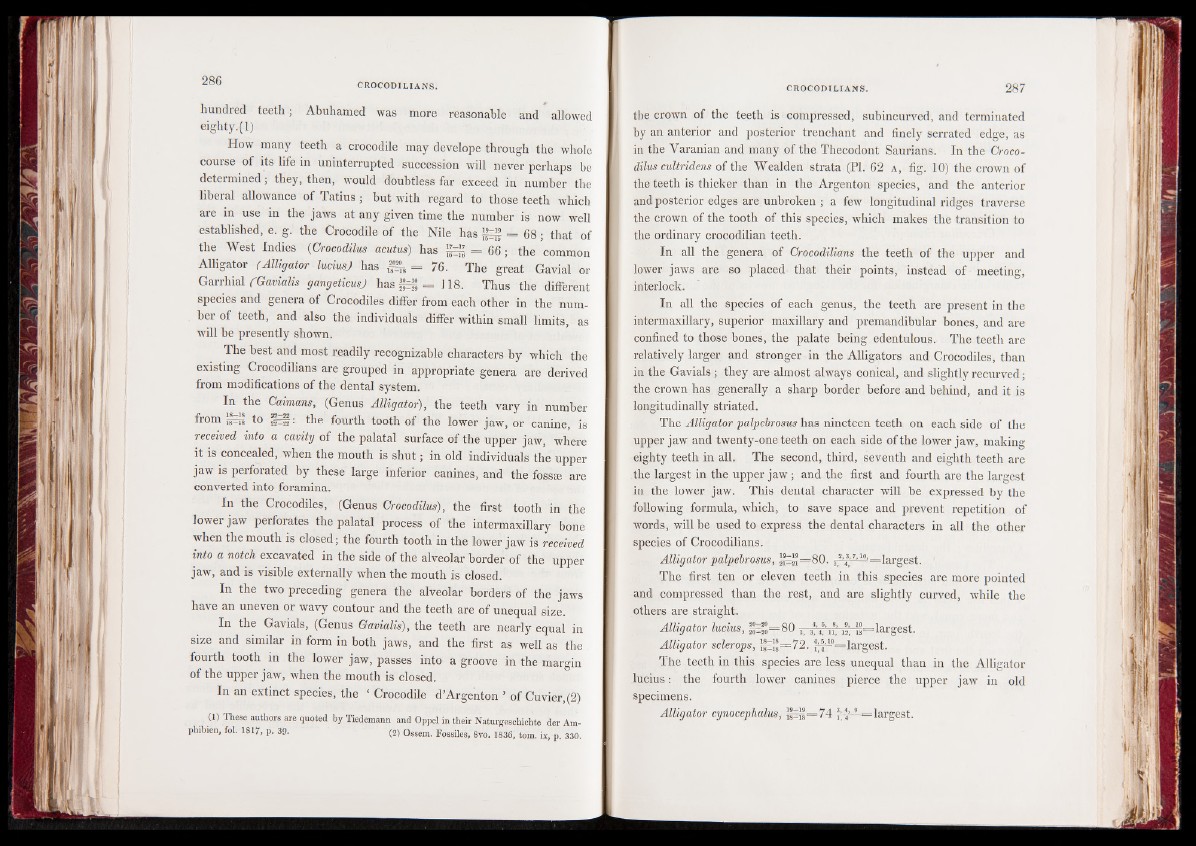
hundred teeth; Ahuhamed was more reasonable and allowed
eighty. (1)
How many teeth a crocodile may develope through the whole
course of its life in uninterrupted succession will never perhaps be
determined; they, then, would doubtless far exceed in number the
liberal allowance of Tatius ; but with regard to those teeth which
are in use in the jaws at any given time the number is now well
established, e. g. the Crocodile of the Nile has jtg = 6 8 ; that of
the West Indies (Crocodilus acutus) has = 6 6 ; the common
Alligator (Alligator luciusj has ®-8 = 76. The great Gavial or
Garrhial fGavialis gangeticusj has | e| = J18. Thus the different
species and genera of Crocodiles differ from each other in the number
of teeth, and also the individuals differ within small limits, as
will he presently shown.
The best and most readily recognizable characters by which the
existing Crocodilians are grouped in appropriate genera are derived
from modifications of the dental system.
In the Caimans, (Genus Alligator), the teeth vary in number
from 18_18 to : the fourth tooth of the lower jaw, or canine, is
received into a cavity of the palatal surface of the upper jaw, where
it is concealed, when the mouth is shut; in old individuals the upper
jaw is perforated by these large inferior canines, and the fossae are
converted into foramina.
In the Crocodiles, (Genus Crocodilus), the first tooth in the
lower jaw perforates the palatal process of the intermaxillary bone
when the mouth is closed; the fourth tooth in the lower jaw is received
into a notch excavated in the side of the alveolar border of the upper
jaw, and is visible externally when the mouth is closed.
In the two preceding genera the alveolar borders of the jaws
have an uneven or wavy contour and the teeth are of unequal size.
In the Gavials, (Genus Gavialis), the teeth are nearly equal in
size and similar in form in both jaws, and the first as well as the
fourth tooth in the lower jaw, passes into a groove in the margin
of the upper jaw, when the mouth is closed.
In an extinct species, the ‘ Crocodile d’Argenton ’ of Cuvier,(2)
(1) These authors are quoted by Tiedemann and Oppel in their Naturgeschichte der Amphibien,
fol. 1817, p. 39. (2) Ossem. Fossiles, 8vo. 1836, tom. ix, p. 330.
the crown of the teeth is compressed, subincurved, and terminated
by an anterior and posterior trenchant and finely serrated edge, as
in the Varanian and many of the Thecodont Saurians. In the Crocodilus
cultridens of the Wealden strata (PI. 62 a , fig. 10) the crown of
the teeth is thicker than in the Argenton species, and the anterior
and posterior edges are unbroken ; a few longitudinal ridges traverse
the crown of the tooth of this species, which makes the transition to
the ordinary crocodilian teeth.
In all the genera of Crocodilians the teeth of the upper and
lower jaws are so placed that their points, instead of meeting,
interlock.
In all the species of each genus, the teeth are present in the
intermaxillary, superior maxillary and premandibular bones, and are
confined to those bones, the palate being edentulous. The teeth are
relatively larger and stronger in the Alligators and Crocodiles, than
in the Gavials; they are almost always conical, and slightly recurved;
the crown has generally a sharp border before and behind, and it is
longitudinally striated.
The Alligator palpebrosus has nineteen teeth on each side of the
upper jaw and twenty-one teeth on each side of the lower jaw, making
eighty teeth in all. The second, third, seventh and eighth teeth are
the largest in the upper jaw; and the first and fourth are the largest
in the lower jaw. This dental character will be expressed by the
following formula, which, to save space and prevent repetition of
words, will be used to express the dental characters in all the other
species of Crocodilians.
Alligator palpebrosus, ^21=80. largest. '
The first ten or eleven teeth in this species are more pointed
and compressed than the rest, and are slightly curved, while the
others are straight.
Alligator lucius, §j=-*==80 i , 3%°'ii,’ ii ^ largest.
Alligator sclerops, i|Ej|==72. £4--°—largest.
The teeth in this, species are less unequal than in the Alligator
lucius: the fourth lower canines pierce the upper jaw in old
specimens.
Alligator cynocephalus, jsEjj==74 = largest.